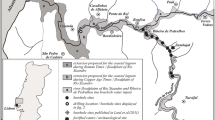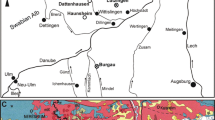Abstract
We used two sediment cores from the ancient harbour of Rome (Italy) for palaeoenvironmental reconstruction. The imperial harbour of Rome and its town, Portus, were constructed in the Tiber Delta area. Today, they are ~3 km from the coast, close to Leonardo da Vinci International Airport. The port was excavated during the reign of Emperor Claudius, inaugurated by Nero in 64 AD, and substantially enlarged under Emperor Trajan. This paper focuses on analyses of ostracods in sediment cores from the harbour and provides insights into the palaeoenvironmental evolution of the harbour water bodies. Pollen data complement this ostracod-based reconstruction, providing information about the vegetation around the port. One core (PTS13) was taken from the dock area (darsena) excavated at the time of Claudius. The second core (PTS5) was collected from the Trasverso Channel (Canale Trasverso), excavated after the port inauguration and later dredged during the fourth century AD because it had filled in with silt. Radiocarbon, archaeological and pollen data indicate the two cores overlap in time slightly, or perhaps not at all, the core from the dock site (PTS13) containing the older record. Ostracods recovered from the two sites represent very different aquatic environments, driven in one case by the Tiber River input and in the other by “marine” harbour waters. Parallel study of ostracods and pollen in the cores reveals the impact of harbour management activities, which are linked to ship hull maintenance, as well as erosion and siltation in this coastal setting.






Similar content being viewed by others
References
Anadón P, Gliozzi E, Mazzini I (2002) Paleoenvironmental reconstruction of marginal marine environments from combined paleoecological and geochemical analyses on ostracods. In: Holmes AH, Chivas AR (eds) The ostracoda: applications to Quaternary research. AGU Geophys Monogr, vol 131, pp 227–247
Bellotti P, Chiocci FL, Milli S, Tortora P, Valeri P (1994) Sequence stratigraphy and depositional setting of the Tiber delta: integration of high resolution seismics, well logs and archaeological data. J Sediment Petrol B64:416–432
Bellotti P, Calderoni G, Carboni MG, Di Bella L, Tortora P, Valeri P, Zernitskaya V (2007) Late Quaternary landscape evolution of the Tiber River delta plain (Central Italy): new evidence from pollen data, biostratigraphy and 14 C dating. Z Geomorph NF 4:505–534
Bellotti P, Mattei M, Tortora P, Valeri P (2009) Geo-archaeological investigations in the area of the imperial harbours of Rome. Méditerranée 112:51–58
Benvenuti M, Mariotti Lippi M, Pallecchi P, Sagri M (2006) Late Holocene floods in the terminal Arno river (Pisa, Central Italy): hydro-climatic catastrophic events and short-term sealevel changes from the history of the Roman riverine harbour. Holocene 16:863–876
Bersani P, Bencivenga M (2001) Le piene del Tevere a Roma dal V secolo a.C. all’anno 2000. In: Servizio idrografico e mareografico nazionale. Presidenza del Consiglio dei Ministri. Dipartimento per i Servizi Tecnici Nazionali, Roma pp 1–100
Bodergat AM, Ikeya N, Irzi Z (1998) Domestic and industrial pollution: use of ostracods (Crustacea) as sentinels in the marine coastal environments. J Rech Oceanogr 23:139–144
Boomer I, Eisenhauer G (2002) Ostracod faunas as palaeoenvironmental indicators in marginal marine environments. In: Holmes AH, Chivas AR (Eds) The ostracoda: applications to Quaternary research. AGU Geophys Monogr, vol 131, pp 135–149
Boomer I, Horne DJ, Slipper IJ (2003) The use of ostracods in palaeoenvironmental studies, or what can you do with an ostracod shell? In: Park LE, Smith AJ (Eds) Bridging the gap. Trends in the ostracode biological and geological sciences. Paleontol Soc paper, vol 9, pp 153–180
Cabral MC, Freitas MC, Andrade C, Cruces A (2006) Coastal evolution and Holocene ostracods in Melides lagoon (SW Portugal). Mar Micr 60:181–204
Camuffo D, Enzi S (1995) The analysis of two bi-millenary series: Tiber and Po river floods. In: Jones PD, Bradley R, Jouzel J (eds) Climatic variations and forcing mechanism of the last 2000 years. NATO-ANSI series, 1: global environmental change, vol 41. Springer, Berlin, pp 433–445
Carbonel P (1982) Les ostracodes, traceurs des variations dans des systèmes de transition eaux douceseaux salées. Mémoire de la Société géologique de France 144:17–128
Cody RD, Cody AM (1988) Gypsum nucleation and crystal morphology in Analog saline terrestrial environments. J Sediment Res 58:247–255
Giordano G, Esposito A, De Rita D, Fabbri M, Mazzini I, Trigari A, Rosa C, Funiciello R (2003) The sedimentation along the roman coast between middle and upper Pleistocene: the interplay of eustatism, tectonics and volcanism—new data and review. Il Quaternario 16:121–129
Giraudi C (2004) Evoluzione tardo-olocenica del delta del Tevere. Il Quaternario 17:477–482
Giraudi C, Tata C, Paroli L (2009) Late Holocene evolution of Tiber river delta and geoarchaeology of Claudius and Trajan Harbor, Rome. Geoarchaeology 24:371–382
Goiran JP, Tronchère H, Salomon F, Carbonel P, Djerbi H, Ognard C (2010) Palaeoenvironmental reconstruction of the ancient harbors of Rome: Claudius and Trajan’s marine harbors on the Tiber delta. Quatern Int 216:3–13
Horne D, Boomer I (2000) The role of ostracoda in saltmarsh meiofaunal communities. In: Sherwood BR, Gardiner BG, Harris T (eds) British saltmarshes. Forrest Text, Cardigan, for the Linnean Society of London, London, pp 181–202
Lachenal AM (1989) Écologie des ostracodes du domaine méditerranéen. Application au Golfe du Gabès (Tunisie orientale): les variations du niveau marin depuis 30000 ans. Documents des Laboratoires de Géologie de Lyon 108:1–239
Mariotti Lippi M, Bellini C, Trinci C, Benvenuti M, Pallecchi P, Sagri M (2006) Pollen analysis of the ship site of Pisa San Rossore, Tuscany, Italy: the implications for catastrophic hydrological events and climatic change during the late Holocene. Veget Hist Archaeobot 16:453–465
Marriner N, Morhange C, Goiran JP (2010) Coastal and ancient harbour geoarchaeology. Geol Today 26:21–27
Masson PH (1955) An occurrence of gypsum in southwest Texas. J Sediment Petrol 25:72–77
Meisch C (2000) Freshwater ostracoda of Western and Central Europe. In: Schwoerbel J, Zwick P (eds) Süsswasserfauna von Mitteleuropa 8/3. Spektrum Akademischer Verlag, Heidelberg, pp 1–522
Mudie PJ, Leroy SAG, Marret F, Gerasimenko N, Kholeif SEA, Sapelko T, Filipova-Marinova M (2011) Nonpollen palynomorphs: indicators of salinity and environmental change in the Caspian–Black Sea–Mediterranean corridor. Geol Soc Am Spec Pap 473:1–27
Paroli L (2004) Il porto di Roma nella tarda antichità. II seminario ANSER, Roma-Ostia Antica 16–17 aprile 2004. In: Gallina Zevi A, Turchetti R (eds) Le strutture dei porti e degli approdi antichi. Rubbettino Editore, Cosenza, pp 247–266
Pugliese N, Stanley DJ (1991) Ostracoda, depositional environments and late Quaternary evolution of eastern Nile Delta, Egypt. Il Quaternario 4:275–302
Rendell HM, Claridge AJ, Clarke ML (2007) Late Holocene Mediterranean coastal change along the Tiber Delta and Roman occupation of the Laurentine shore, central Italy. Quat Geochron 2:83–88
Ruiz F, González-Regalado ML, Muñoz JM, Pendón JG, Rodríguez-Ramírez A, Cáceres L, Rodríguez-Vidal J (2003) Population age structure techniques and ostracods: applications in coastal hydrodynamics and paleoenvironmental analysis. Palaeogeogr Palaeoclimatol Palaeoecol 199:51–69
Sadori L, Giardini M, Giraudi C, Mazzini I (2010a) The plant landscape of the imperial harbour of Rome. J Archaeol Sci 37:3294–3305
Sadori L, Mercuri AM, Mariotti Lippi M (2010b) Reconstructing past cultural landscape and human impact using pollen and plant macroremains. Plant Biosyst 144:940–951
Sallares R (2006) Role of environmental changes in the spread of malaria in Europe during the Holocene. Quatern Int 150:21–27
Whatley RC (1988) Population structure of ostracods: some general principles for the recognition of palaeoenvironments. In: De Deckker P, Colin J-P, Peypouquet J-P (eds) Ostracoda in the earth sciences. Elsevier, Amsterdam, pp 245–256
Acknowledgments
We thank Lidia Paroli from Soprintendenza Speciale per i Beni Archeologici di Roma who kindly provided the cores drilled in the archaeological area. We acknowledge the help of Dr. Sergio Lo Mastro (Roma 3 University) for XRD analyses of the gypsum crystals and useful discussions. The work was partly financed by the Italian PRIN (2008FJCEF4) project PICAR (Cultural landscape and human impact in circum-Mediterranean countries). The comments and suggestions of two anonymous referees and of Dr. Mark Brenner (University of Florida) considerably improved the manuscript.
Author information
Authors and Affiliations
Corresponding author
Electronic supplementary material
Below is the link to the electronic supplementary material.
Rights and permissions
About this article
Cite this article
Mazzini, I., Faranda, C., Giardini, M. et al. Late Holocene palaeoenvironmental evolution of the Roman harbour of Portus, Italy. J Paleolimnol 46, 243–256 (2011). https://doi.org/10.1007/s10933-011-9536-7
Received:
Accepted:
Published:
Issue Date:
DOI: https://doi.org/10.1007/s10933-011-9536-7




